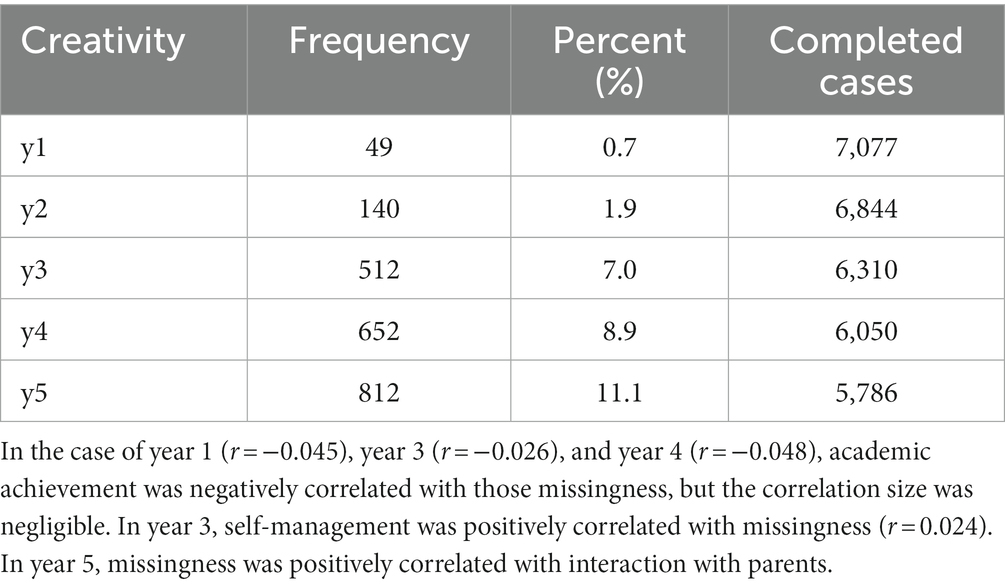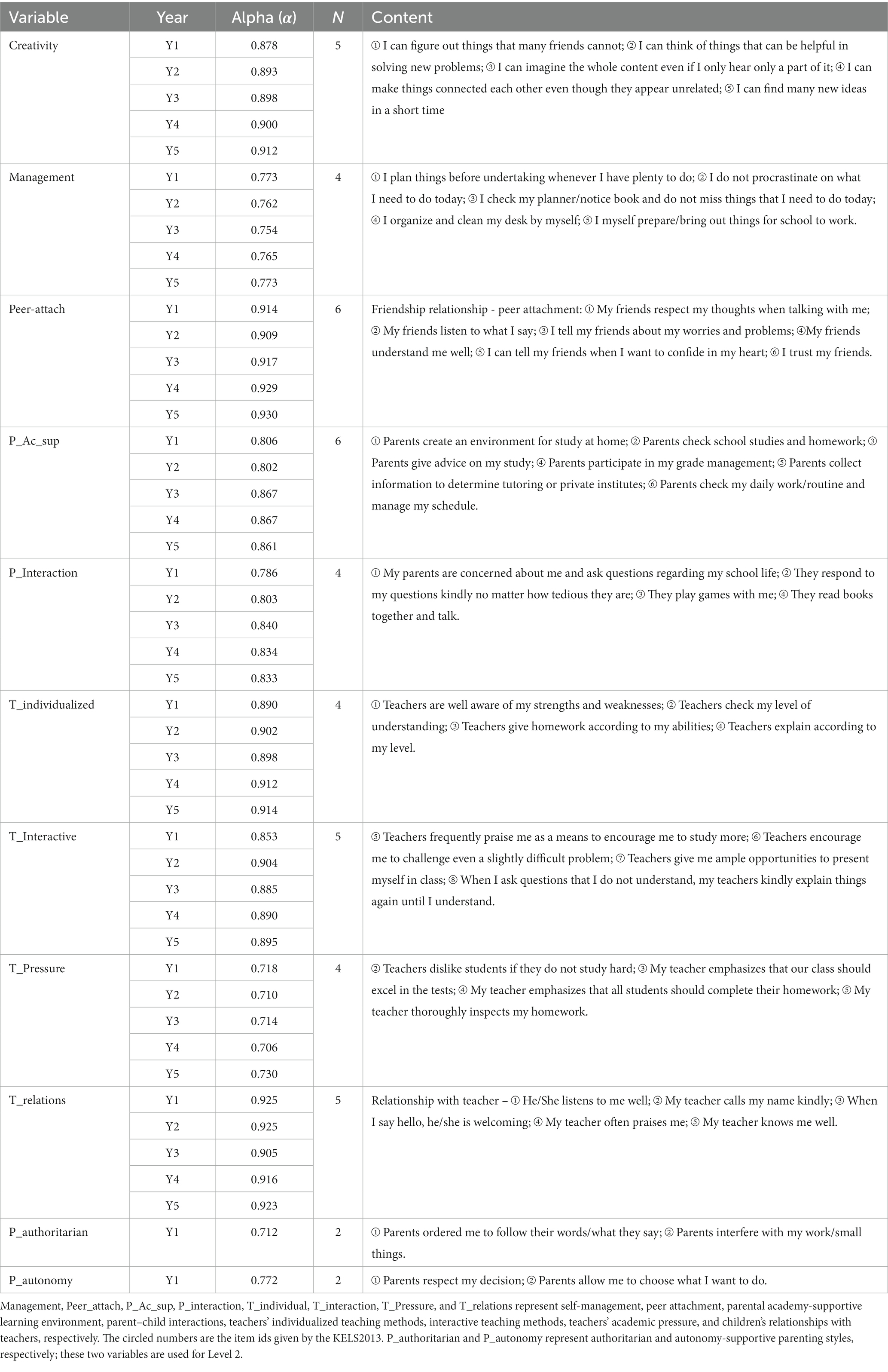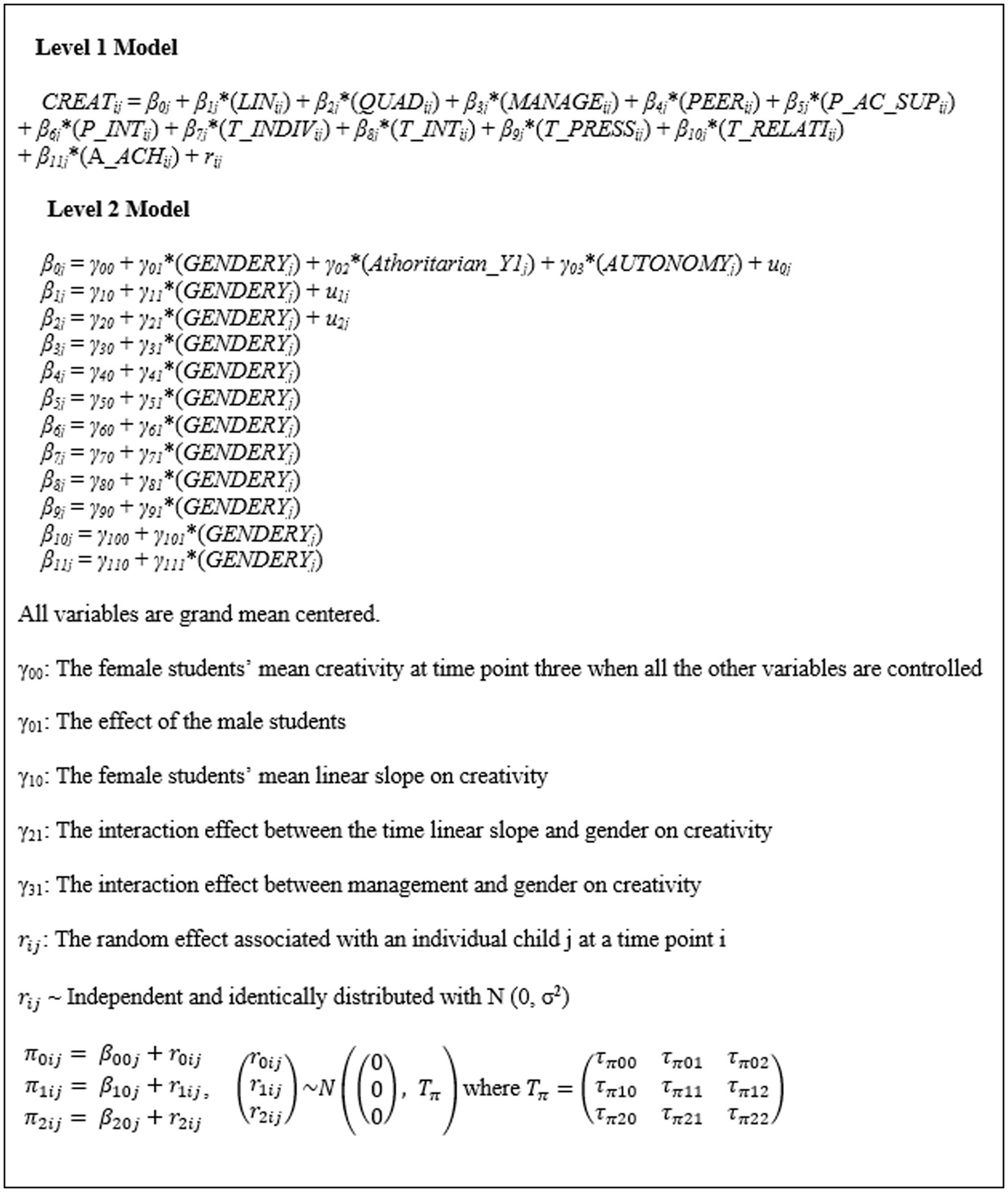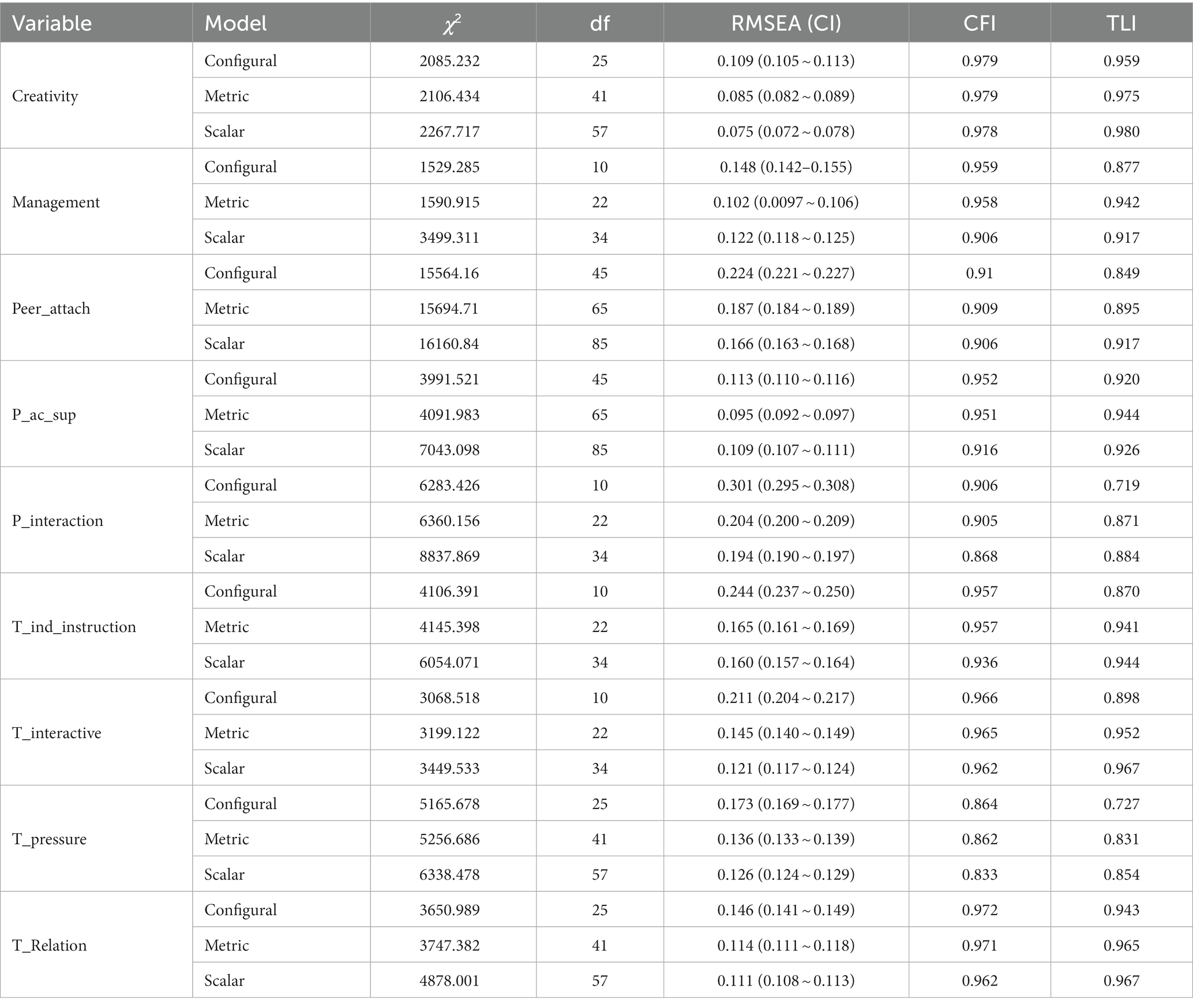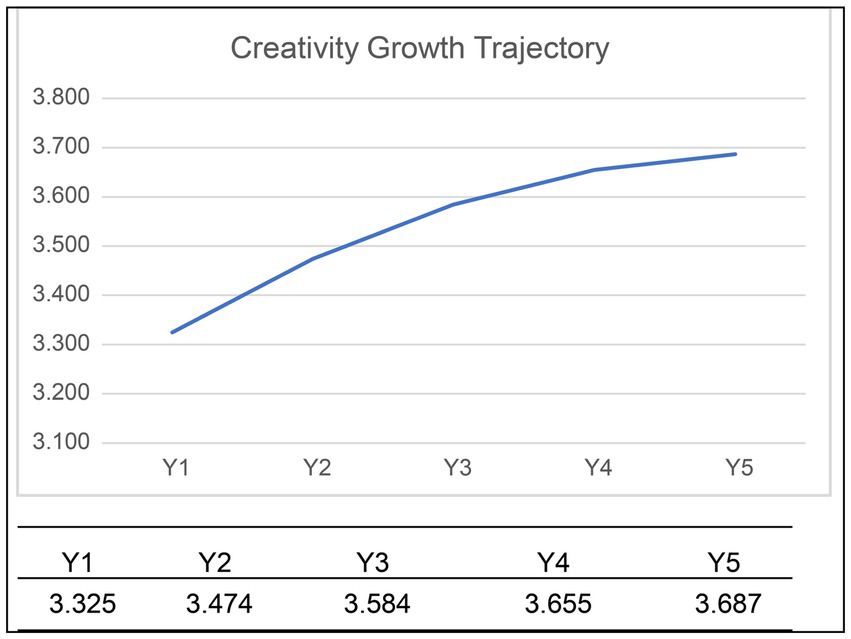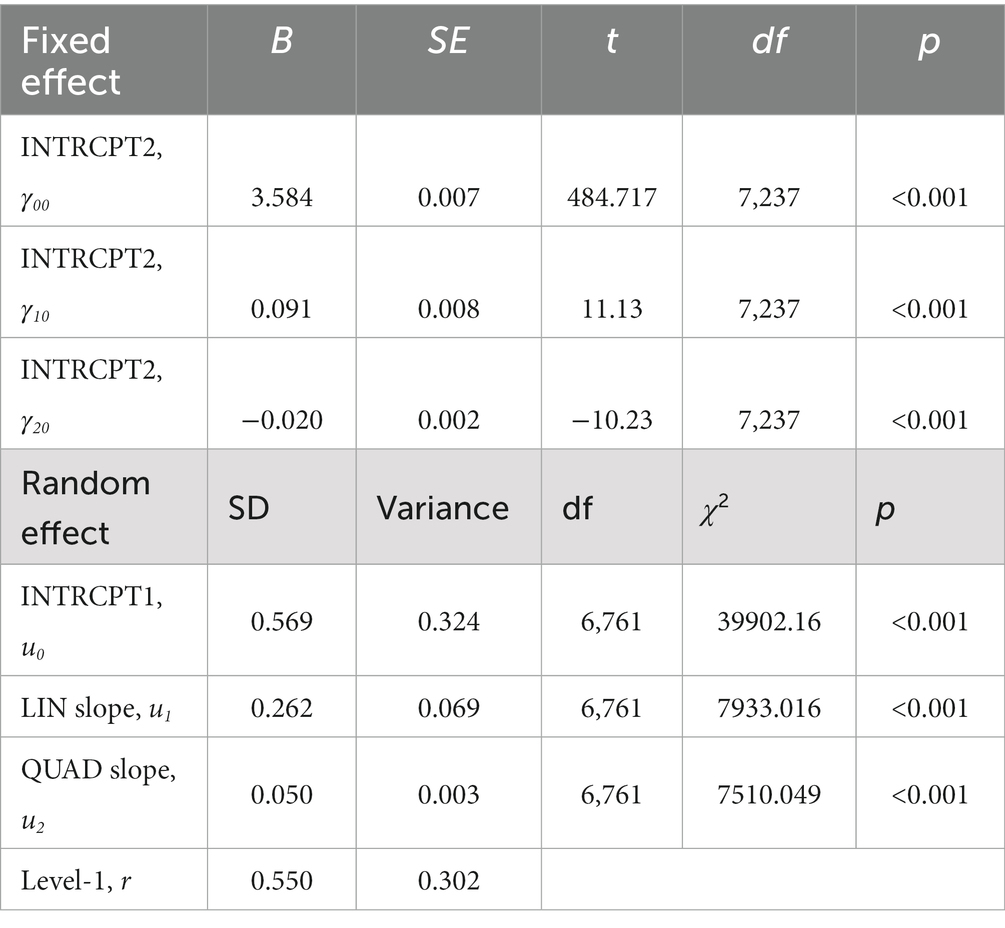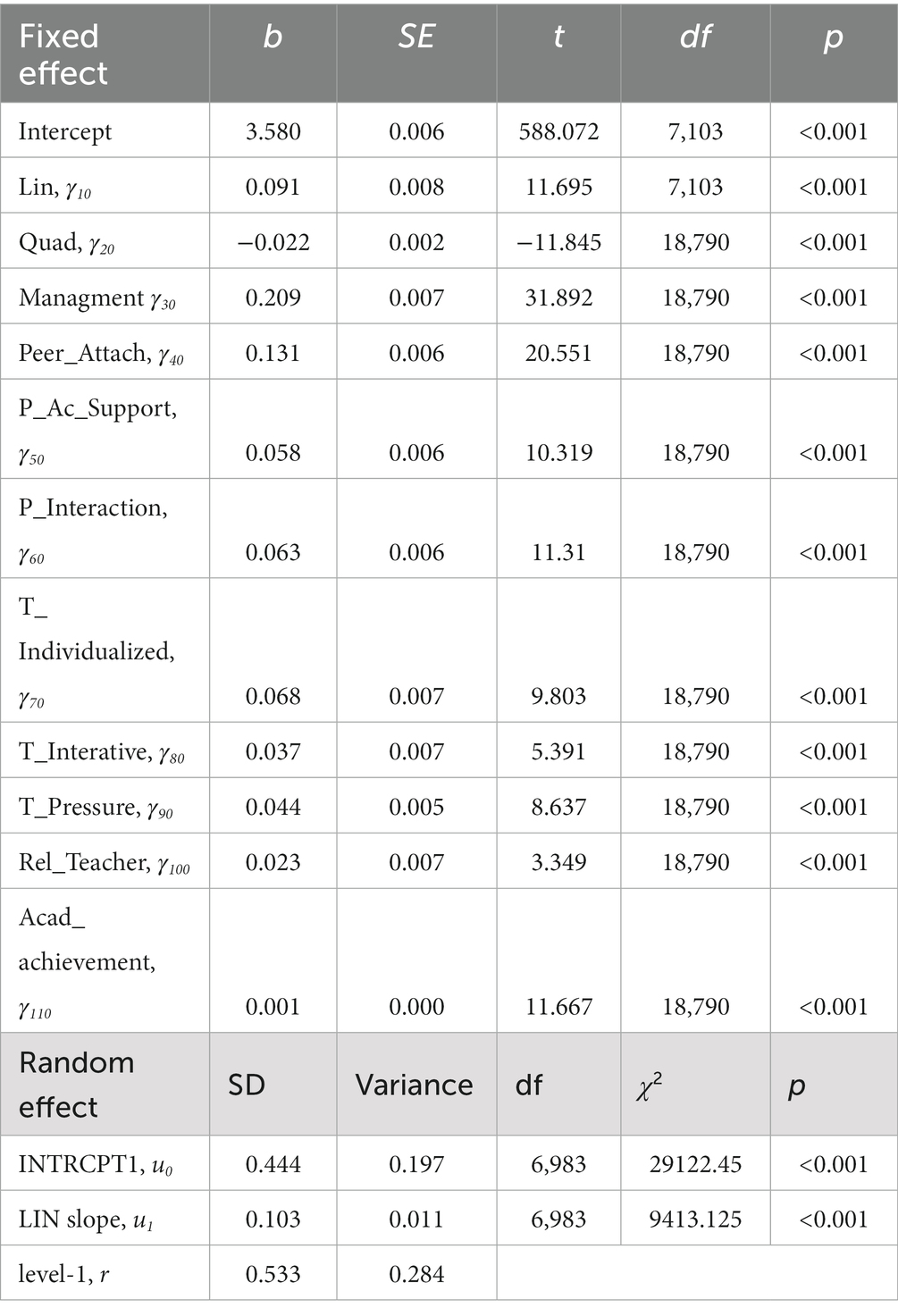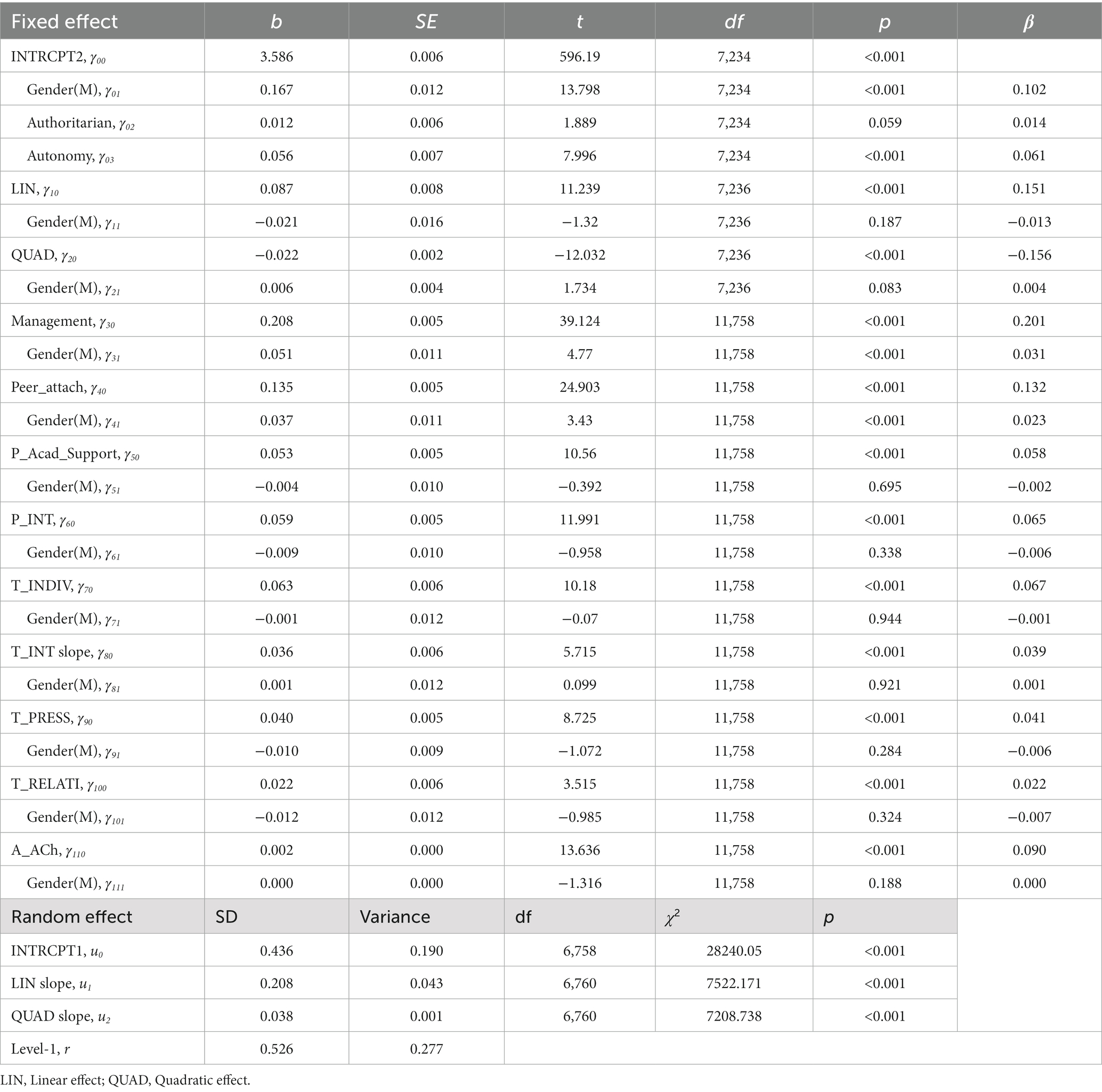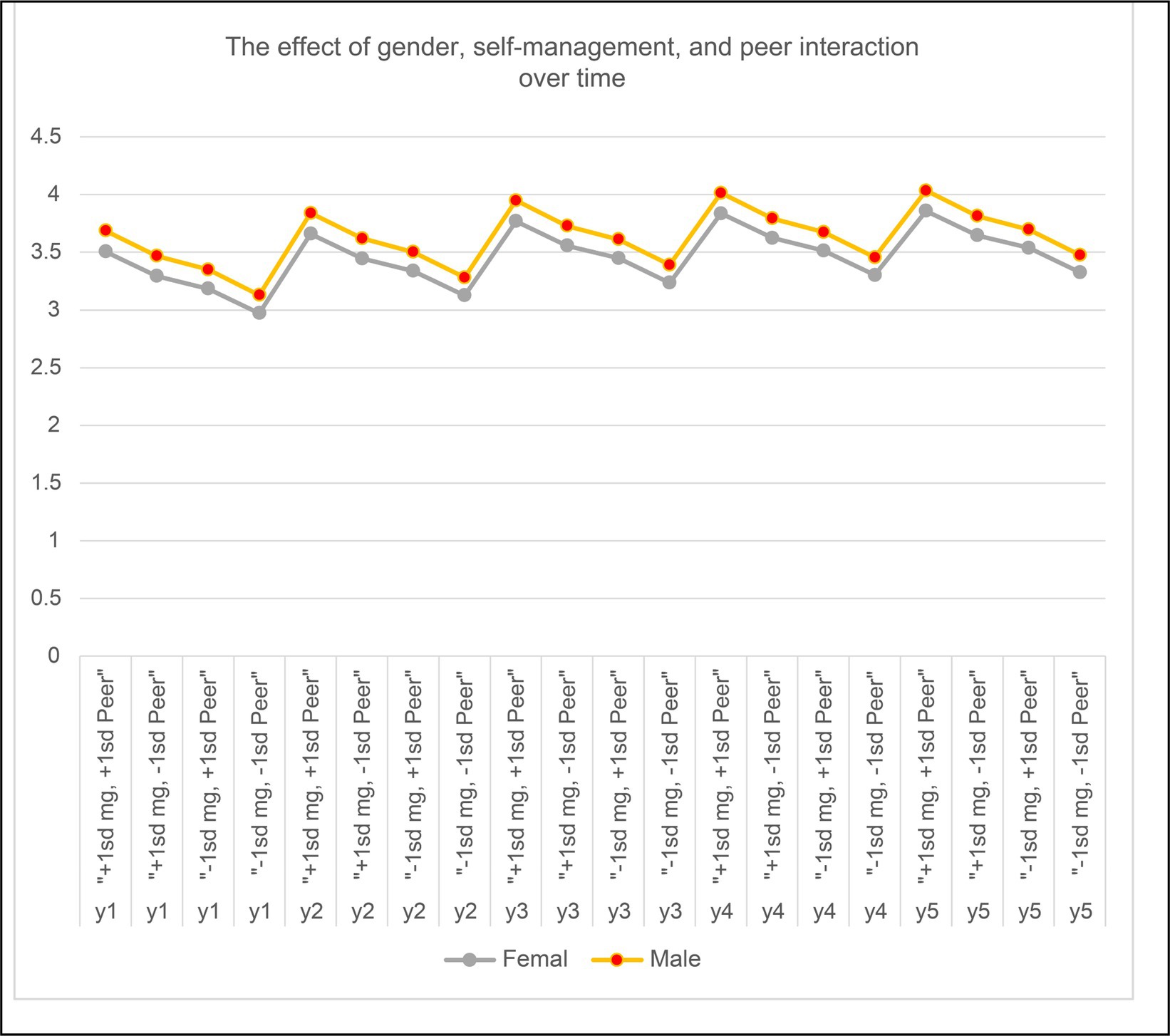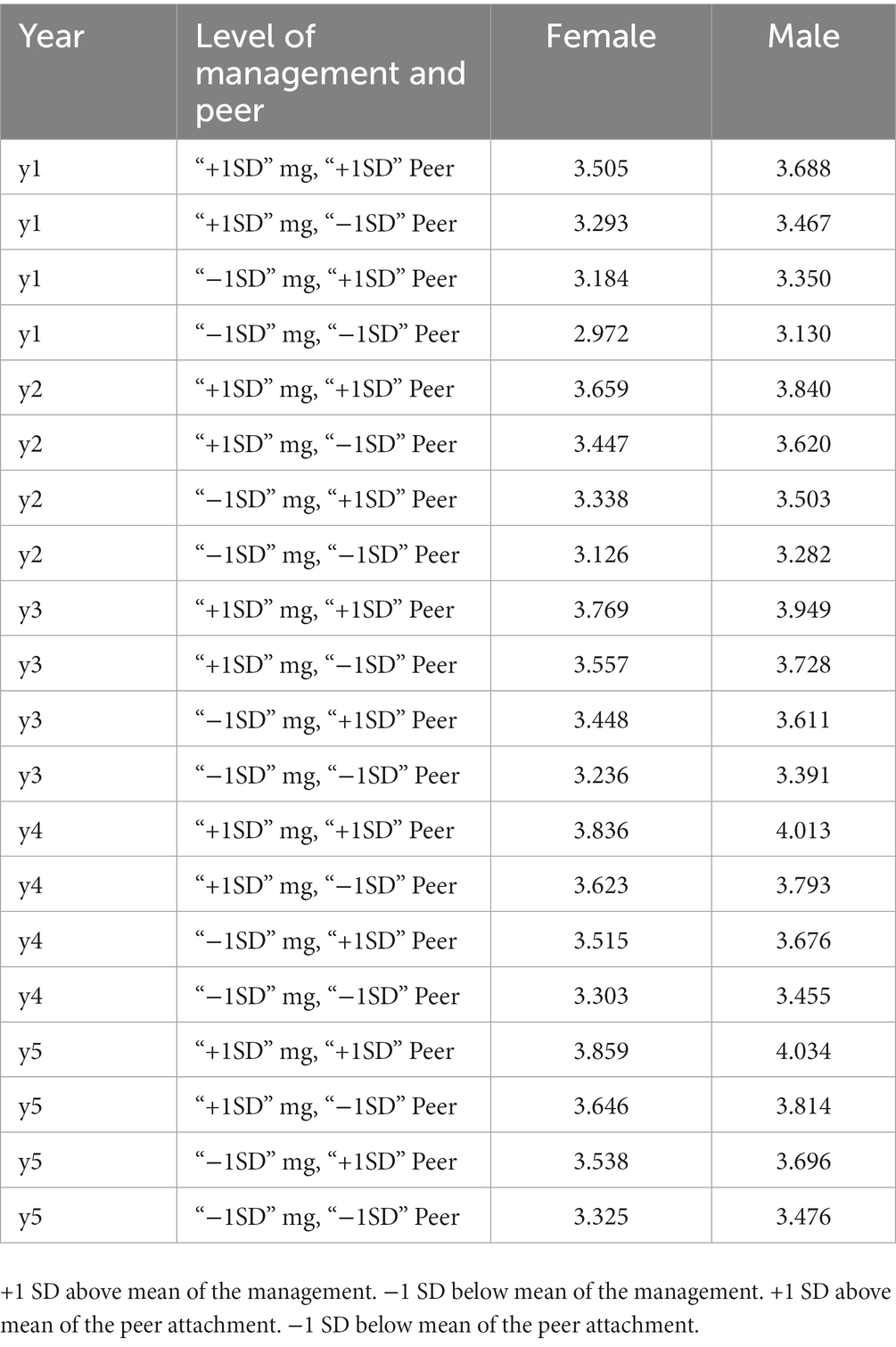- 1Graduate School of Education, Honam University, Kwangju, Republic of Korea
- 2The Institute for Educational Research, Yonsei University, Seoul, Republic of Korea
- 3College of Education and P-16 Integration, The University of Texas Rio Grande Valley, Edinburg, TX, United States
- 4Graduate School of Education, Incheon National University, Incheon, Republic of Korea
This longitudinal study investigated how characteristics of individual and social relationships affect Korean students’ creativity development. Fifth graders (male: 3,623, female: 3,701) from 242 schools in Korea were followed annually from their 5th to 9th grades (indicating from the 5th elementary school grade to the 3rd middle school grade in the Korean school system). Exploratory factor analysis, internal consistency reliability (coefficient alpha), confirmatory factor analysis, and two-level growth model methods were performed. We investigated all nine constructs and their related items by checking metric and scalar invariance assumptions. When the measurement invariance assumptions were satisfied, we used the mean of items that constitute respective factors. We checked growth trajectories of creativity and tapped the possibility of the existence of subgroups based on the growth/change pattern using latent class growth modeling. The results showed that no subgroups existed. Thus, we constructed a two-level growth model to investigate the overall growth pattern of the students. Regarding level 1, we included time-varying variables such as peer attachment, self-regulation habits (self-management), parents’ academy-oriented involvement, parent affective support, individualized, interactive teaching methods, teachers’ academic pressure, and academic achievement. At level 2, we used gender and parenting style that was obtained at time point 1. The final combined model incorporating level 1 and 2 variables showed that students’ self-regulation had the most association with the student’s creativity followed by peer attachment, parents’ academic support, interaction with parents, interaction with teachers, academic pressure from teachers, and relationships with teachers. Methods for enhancing students’ creativity were discussed.
1. Introduction
Creativity refers to when one solves a problem in a way different from the existing methods or verifies usability by applying previous knowledge to a new area (Sternberg and Lubart, 1996). Beyond the personal dimension, various factors in the social context interact with each other and influence the development of creativity. Because of its novelty and usability, creativity has received considerable attention across various academic fields, including sociology, management, humanities, and education. Although the word “creativity” seems to encompass fancy features and has been defined in different ways, its core idea includes an ability to display originality, imagination, and expressiveness (American Psychological Association, 2023). Creativity is an individual’s ability to solve new problems with novelty by connecting various strategies and possibilities. Considering that creativity is an abstract concept, it is difficult to measure its construct. Thus far, creativity researchers have investigated it as a measurable ability and sought to discover its constituting factors. The measure is achieved sometimes through performance-based tasks such as by analyzing artifacts produced by an individual or by asking an individual to perform certain tasks (Antonietti and Colombo, 2012), and sometimes through self-report measures (Silvia et al., 2012). Importantly, self-report measures are usually not meant to serve as proxies for creative abilities or skills, but rather to reflect an individual’s beliefs about one’s own creativity. Efforts have been focused on understanding how a creative attitude is influenced by an individual’s cognition, attitude, and environmental factors (Csikszentmihalyi, 1999; Kim et al., 2002). In this study, we consider self-report, an individual’s own reflection of their attitude and behaviors, as a tool to measure creative ability. We address here the factors that we consider have influenced an individual’s creativity.
1.1. Cognitive factors
One approach to creativity research explores the cognitive characteristics of creative thinking, such as divergent (Guilford, 1950), associative (Mednick, 1962), analytical (Sternberg et al., 2005), and flexible thinking (Kenett et al., 2018). Researchers who view creativity from a cognitive perspective have focused on the possibility of it being an individual competence that can be measured through experimentation or a psychometric method. Guilford (1967) and Torrance (1980) proposed that creativity is related to cognitive abilities, especially divergent thinking skills, such as sensitivity to problems, fluency in thought, flexibility, originality, and elaborateness for segmenting and clarifying things. There is a rich body of research on the cognitive processes involved in creativity (Sawyer, 2012; Lee and Therriault, 2013; Cassotti et al., 2016). It is assumed that conflict monitoring (Ruzzoli et al., 2020), inhibitory control (Radel et al., 2015), and working memory (Beaty et al., 2014) are related to creative activities. Specifically, people’s ability to manage thinking processes through cognitive control and inhibition can be revealed through their behavior, which is then connected to how they control their thinking process when working on a certain task (Buckley et al., 2014; Tiego et al., 2018).
Considering the underlying cognitive mechanisms embedded in cognitive control, those engaged in creativity share many common features with those involved in self-regulation. According to Zimmerman (2001), “self-regulation refers to the self-directive process through which learners transform their mental abilities into task-related skills.” Managing one’s thinking and behaviors needs cognitive ability. It is the process of managing and monitoring one’s thinking and problem-solving processes to reach a designated goal (Berk, 2003). Specifically, self-regulated learning monitors and controls how students interact with learning tasks in their everyday lives (Zielińska et al., 2022a,b).
From the students’ perspective, self-regulation includes allocating adequate mental resources to an appropriate stage in the problem-solving or thinking processes (Shell et al., 2013). It is also known to mediate the transformation of creative ideas into creative products (Beeftink et al., 2012; Ivcevic and Nusbaum, 2017) and competency (Shell et al., 2013); moreover, it works collectively with metacognition to help creative thinking (Whitebread et al., 2009; Lizarraga and Baquedano, 2013). Considering that students’ creativity is evaluated in a school setting, measuring the students’ planning and controlling learning behaviors could be a strong predictor of creative behaviors and products (Rubenstein et al., 2018; Zielińska et al., 2021). We hypothesized that their self-regulation behaviors are positively related to their creativity.
Owing to its nonlinearity and multilayered characteristics, research on creativity needs to consider a broader but structured approach to understand its underlying nature. Aligned with its relationship to cognition, creativity is highly influenced not only by an individual’s competence but also by dynamics in an ecological system.
1.2. Social and ecological factors
According to Bronfenbrenner’s (1974) ecological framework, an individual interacts with and is influenced by various surrounding ecological systems. Especially for students in an education system, environmental factors, including the home ecological system and the school culture greatly impact children’s behavior, creative attitude, and thinking process, in addition to their innate qualities. As part of the home ecological system, parents’ attitudes are critical in forming a child’s creative characteristics (Pugsley and Acar, 2018). The former’s knowledge and beliefs about their parenting are related to their supportive behaviors toward their children, which in turn are related to the latter’s classroom behaviors (Bornstein et al., 2018). In addition, parents’ less supportive relationships with teachers implicate their children’s low achievement in school (Hughes and Kwok, 2007). A socio-cultural factor influences how individuals approach and solve a problem. For example, people from diverse cultures exhibit differences in their preferred creative processes (Rudowicz and Yue, 2002; Chua, 2018). Previous studies have indicated how micro-, meso-, and exo-systems and socio-cultural environments inevitably interact with each other influencing an individual’s development; this is revealed as students’ knowledge, attitudes, and behavior (Schilhab and Esbensen, 2019; Newman and Newman, 2020). At the same time, these interact with each other in all aspects of the students’ lives, including their knowledge, creative attitude, and behavior (Bronfenbrenner, 1986).
Through a multivariate behavioral genetic analysis, Kandler et al. (2016) found that creativity was explained more effectively by environmental factors. Again, this indicated that students’ creative behavior and attitude are closely related to their home and school environments, such as parenting style and interaction with parents, relationships with teachers, and school culture. Regarding the social factors’ influence on pupils, the home and school environments are inevitably mentioned. In this study, the home environment included parenting style, where a fosterer interacts with children, and the aspects they emphasize in everyday life. Hoferichter et al. (2021) found that German students from grade 7 and 8 who perceived their parents as supportive showed satisfaction with more various dimensions than those who perceived their teachers or peer as supportive.
Parents have the most impact on child development. Due to the significant influence of parenting styles on children’s cognitive, behavioral, and emotional development (Baumrind, 1966; Maccoby and Martin, 1983; Mehrinejad et al., 2015; Kuppens and Ceulemans, 2019; Pérez-Fuentes et al., 2019), parenting styles are the fundamental social factor influencing students’ creativity. Students’ creativity should be considered within the concept of parenting style and its relation to their creative attitude. Since Baumrind (1966) initially categorized three types of parenting styles, Maccoby and Martin (1983) expanded it using a two-dimensional framework that included authoritative, authoritarian, permissive, and uninvolved styles. The core idea is that children perceive the world and cope with problems differently, depending on the degree of parents’ responsiveness and demands. For example, an authoritarian style is based mainly on controlling a child, which is negatively related to creativity (Lim and Smith, 2008; Mehrinejad et al., 2015). However, authoritative and permissive styles are based chiefly on care and interest in the children, which was found to support creativity (Miller et al., 2012; Fearon et al., 2013; Popescu et al., 2015). An earlier review by Miller and Gerard (1979) demonstrated that the parents of creative children show respect, independence, and freedom toward their children. While the parents’ broad acceptance of their children’s performance outcomes is positively related to the latter’s creativity (Fan and Zhang, 2014), restraining them excessively, such as expecting higher grades or performance, diminishes it (Jankowska and Karwowski, 2014).
The key to the relationship between a parenting style and its impact on children is whether the style implemented by parents or nurturers is perceived by the children as intended. For instance, a father sets a clear rule to support his child’s behavioral needs, which is a feature of authoritative parenting. However, this can be interpreted as extreme pressure or a burden on the child. Thus, it can be considered an authoritarian style. In this sense, parenting style is to be judged from a child’s perspective.
Creativity relies on creative self-concept (Karwowski et al., 2019) that is greatly influenced by parent–child interactions. Therefore, parental support is a critical resource that can equip individuals with what they need; it simulates how things happen before stepping toward an unknown world. Parental support is closely associated with adolescents’ decision-making regarding their career choice (Kush and Cochran, 1993) and efficacy in pursuing mathematics and science subjects (Lopez et al., 1997). Therefore, parental cognitive and affective support function as stepping stones before and during the life-long journey; furthermore, their impact continues throughout an individual’s life (Neitzel and Stright, 2003; Leerkes et al., 2011). Accordingly, we hypothesized that the parents’ cognitive and affective support would be positively related to their children’s creativity.
A teacher’s pedagogical knowledge is another key aspect influencing students’ creativity; this is because it determines how the former interacts with the latter and what aspects are emphasized, which in turn influences the students’ ways of thinking, approaching a problem, and curiosity. Specifically, the student-teacher interaction patterns influence the level of pupils’ creative products (Pellegrini, 1984; Torrance and Goff, 1989; Kupers and van Dijk, 2020). It has been argued that educators effectively develop creativity and share common characteristics, some of which include providing an atmosphere of acceptance, asking thought-provoking questions, and valuing originality (Clark, 1983). Torrance and Goff (1989) suggested that teachers who provide students with opportunities to improve divergent problem-solving abilities will further enhance their development of creative thinking abilities. By analyzing student-teacher interaction patterns and products, Kupers and van Dijk (2020) investigated the process of how creativity emerges in the interaction between educators and students using a musical composition task. They found that convergent interaction between them created a barrier to creative output. This result aligned with the findings of other previous studies (Torrance and Goff, 1989; Lee and Kemple, 2014). For example, Torrance and Goff (1989) reported that the way teachers respond to students, such as creating a more responsive environment, is essential to the establishment of creativeness via the teacher-student relationship. The findings shared the idea that the teachers of young pupils were able to motivate them to demonstrate creative behaviors through positive verbal interactions (Feitelson and Ross, 1973; Pellegrini, 1984). Hence, we hypothesized that teacher support would be positively related to students’ creativity.
Peer attachment plays an important role in students’ lives. In particular, during adolescence, relationship with peers have a greater impact than those with teachers. For example, negative peer relationships such as bullying are correlated with low academic self-efficacy (Andreou and Metallidou, 2004). Peer attachment includes the concepts of respect, care, and trust, and encompasses cognitive and affective bonds.
Positive peer relationships, especially in adolescence, are related to the development of positive affect (Jose, 2015); moreover, they are helpful in overcoming negative family problems (Gauze et al., 1996; Hodges et al., 1999). They are also good predictors of academic self-concept (Shulman, 1993; Calero et al., 2014). Students’ high academic self-concept is positively associated with self-regulation strategies such as diligence, conception, and information processing (Ommundsen and Lemyre, 2007). These findings imply that peer attachment is influential and mediate many factors related to creativity. Although peer attachment is an important factor in both academic performance and affective stability, limited studies have explored the relationship between peer attachment and creativity, especially for students. We hypothesized that peer attachment would be related to creativity. Several attempts have been made to explore the complex dynamics embedded in creativity (Mumford and Hunter, 2005; Shell et al., 2013; Kharkhurin, 2014; Wu et al., 2014), studies have rarely investigated the longitudinal interrelationship of environmental factors and their impact on students’ creativity with a multi-level approach. Thus, accepting the integrative perspective of creativity (Amabile, 1983; Kim et al., 2002), this study aimed to discover the characteristics influencing students and their surrounding environmental aspects regarding their creative attitudes. Accordingly, we investigate how individual and social factors surrounding the students interact with each other and how these interactions influence their creativity.
We hypothesized that (1) individuals’ cognitive (self-regulation skills) and socio-cultural factors interact and affect their creativity, and (2) the sociocultural factors will have varying degrees of influence such as parenting style, peer factors, and interaction with teachers. The concept of creativity transcends a person’s cognitive aspect and reflects time and society; therefore, investigating how creativity is influenced by the society and culture that an individual learner belongs to has many implications in the sense that it can help society and schools mutually create enhanced learning environments for students to prepare for an uncertain future.
1.3. Gender
Considering the cognitive and socio-cultural influences mentioned above on creativity, this study considers gender that may moderate creative attitude and behaviors. Previous empirical studies have shown inconsistencies in gender superiority. Further, research targeting adolescents have demonstrated mixed results in the relationship between gender and creativity. This study examines how gender associates with creativity when both cognitive and sociocultural factors are considered. First, in some studies, males had higher levels of creativity (Zheng and Xiao, 1983; Rajendran and Krishnan, 1992; Abraham et al., 2013; He and Wong, 2021). For example, Zheng and Xiao (1983) compared male and female students’ creativity based on divergent thinking and creativity ratings by students’ teachers. They found that the former indicated higher creativity than the latter. Abraham et al. (2013), in their behavioral and functional magnetic resonance imaging research, showed that while there was no behavioral difference between males and females regarding various creative thinking tasks, only certain brain regions for both groups were activated during the tasks. In a divergent thinking exercise, males and females showed strong activation in brain areas related to declarative memory and social perceptions, which are central to the theory of mind and the theory of self-referential processing, respectively. This finding implied the involvement of a distinctive neurocognitive mechanism in creative thinking; men are more task-oriented, while women are more socially oriented.
Second, a series of studies reported higher creativity among female students (Kim and Michael, 1995; McCrae et al., 2002; Misra, 2003; He, 2018; Ivcevic et al., 2022). He (2018) explored a dynamic pattern of gender differences in creative thinking through 4 years of a longitudinal study, in which creative thinking for 775 participants from three age groups (children, adolescents, and emerging adults) was assessed using creative thinking drawing production and compared at one-year intervals. This study found that females had higher creativity during early adolescence.
Lastly, some studies indicated no gender differences (Kaufman, 2006; Baer and Kaufman, 2008; Cheung et al., 2010; Taylor and Barbot, 2021; Zielińska et al., 2022a,b). Although there was a gradual increase in the grade level, no gender difference was found between grades 1 and 9 (Cheung et al., 2010). In their review research, Baer and Kaufman (2008) showed that there were more studies with no gender differences in creativity than those with male or female superiority. Kaufman (2006) assessed the creative self-perceptions of 3,553 students and community members in 56 domains distributed across five factors. It was found that males scored higher on two of the five factors and 28 of the 56 domains, while females scored more on two factors and 15 domains. Considering the differences in the neural mechanisms’ dominant function (Abraham et al., 2013; Takeuchi et al., 2015), the gender gap relies on the creativity task, its involved cognitive and neural mechanisms, and the context in which the measure is administered. Since this study is based on students’ self-report of creativity in their problem-solving and divergent thinking behaviors and attitude in a school setting where it was found that the influence of peers is maximized, especially during adolescence, we hypothesized that at some points, the male students would be more creative than their female counterparts.
1.4. Age
The above-mentioned approaches need to be further considered with age-related variables (Sternberg, 1985; Razumnikova and Bakaev, 2022). This is because diverse cultural and contextual factors change constantly and influence individuals in distinct ways. Moreover, various social and ecological aspects are intertwined (Glǎveanu, 2010; Sawyer, 2012; Choe and Pyo, 2014; Glăveanu et al., 2020). This notion is represented in Figure 1 as a conceptual framework of the study. Choe and Pyo (2014) found that people in their twenties recognized creativity differently from those in their fifties. Given that the concept of creativity can be perceived and recognized differently over a period of time even within the same cultural boundary, it is necessary to conduct longitudinal studies of creativity across different time points. These findings highlight the necessity and importance of tracking changes in creativity over time. Similarly, Lubart (1999) suggested investigating changes among generations regarding the concept of creativity to better understand the influence of environmental context. The socio-cultural context’s impact on creativity has been supported by many previous studies that demonstrated creativity-related personality traits, including different socio-cultural factors (Miller and Gerard, 1979; Oral et al., 2007; Kaufman et al., 2009; Kandler et al., 2016). Although there are various ways of defining creativity, we used the term “creativity” as characteristics of association, flexibility, and uniqueness, given that we utilized the existing survey data which assessed creativity covering the three aspects mentioned above.
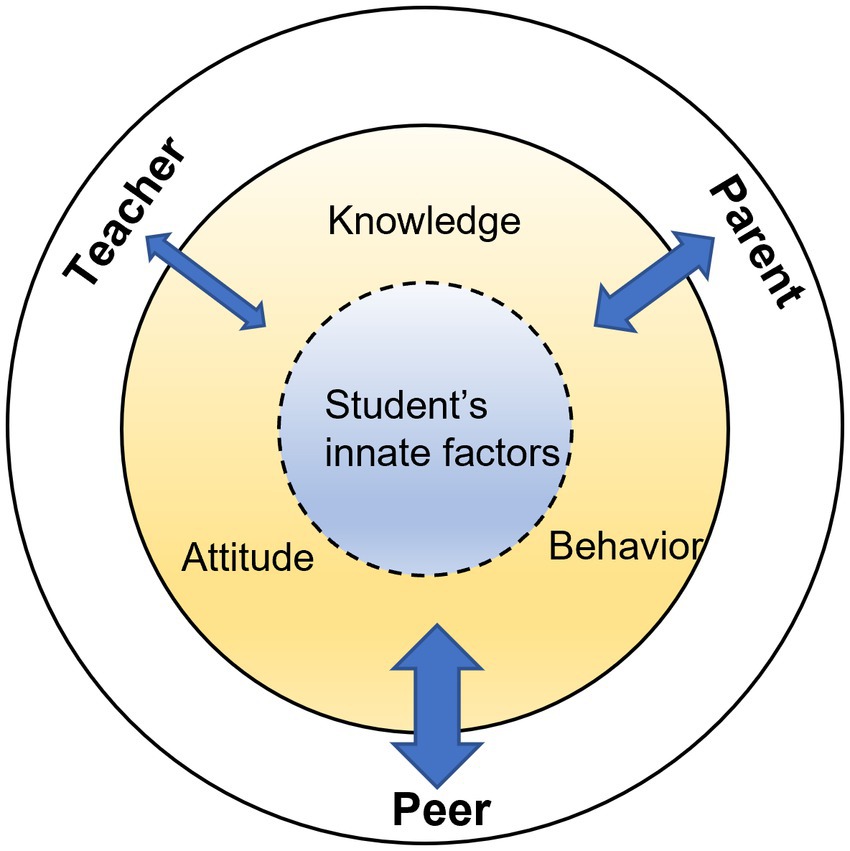
Figure 1. Observed influence of individual and social factors on a student’s creativity (Arrows indicate influential power).
In this study we investigate from grade 5 to grade 9 (before high school year). Because the Korean Education Longitudinal Study (KELS) survey data was collected from 5th grade students (starting point), and full scaled preparation for college entrance exam starts from high school age in Korea, where majority of the students only focus on practicing exams to get higher scores by attending private institute or attending crash courses. We assumed that these learning behaviors during high school period do not adequately correspond to creativity. Specifically the followings are our research questions:
1. Whether and how the elementary students’ creativity changes across 5 years? (no change, linear trend or curved trend).
2. Whether and how are individuals’ cognitive (self-regulation skills, academic achievement) and socio-cultural factors (parents, peers, teachers) associated with the students’ creativity.
3. Whether and how do gender moderate the effect of the students’ other individual (self-regulation skills, academic achievement) and socio-cultural factors (parents, peers, teachers)?
4. Does growth trajectory differ based on gender?
2. Methods
2.1. Subjects
The subjects were from the Korean Education Longitudinal Study (KELS) 2013. Korean Educational Development Institute (KEDI) has been collecting data from 5th grade elementary students, their parents, teachers, principals, and schools from 2013 and it is available upon request through its home page. It was designed to collect students’ educational experiences, outcomes, school environment, educational activities, and organization climate longitudinally to obtain empirical evidence on the effect of educational policy, to assess educational outcomes, and to find out the results of social/class mobility through education. The survey was administered to those who consented via mail with the help of a professional organization with the approval of the board of IRB housed in the KEDI. Using a three-stage stratified sampling method, i.e., geographical region, school level, and class level across the whole South Korea, were collected. The study data are from the 5th graders obtained for 5 years (till 9th grade equivalent to Korean middle school 3rd year). Overall, 7,324 students participated in this survey. Among them, 3,623 (49.5%) and 3,701 (50.5%) were male and female students, respectively. The survey responses were followed annually from the 5th to the 9th grade, so there were some missing cases. In case of responses to creativity, only the completed cases were considered for analysis (see Table 1).
Based on our review of research, we hypothesed that (1) students’ creativity is not stable, it will be changing over 5 time points, (2) individuals’ cognitive and socio-cultural factors such as parents and home environment, friends, and teachers at school influence the students’ creativity, (3) some variability will exist in growth pattern (subgroups may exist or individual growth pattern may differ around mean).
2.2. The KELS child survey items
We identified groups of items related to creativity, self-regulation (self-management), peer attachment, parenting, teacher, and academic achievement which were recognized as individual constructs. The parenting style and support constructs comprised authoritative vs. autonomy-related parenting style, study-supportive parent assistance, and parent–child interactions. In addition, the perceptions of teachers/school culture, teaching methods (individualized and interactive instructions), and teachers’ interactions with students were identified.
The survey items were measured on a five-point Likert scale. The five items related to creativity were: (1) I can figure out things that many friends cannot; (2) I can think of things that can be helpful in solving new problems; (3) I can imagine the whole content even if I hear only a part of it; (4) I can make things connected each other even though they appear unrelated; and (5) I can find many new ideas in a short time. The students’ regulation-related items were also identified: (1) I plan things before undertaking whenever I have plenty to do; (2) I do not procrastinate on what I need to do today; (3) I check my planner/notice book and do not miss things that I need to do today; (4) I organize and clean my desk by myself; (5) I myself prepare/bring out things for school to work.
Regarding parenting, two groups of items were obtained at each time point and employed for level 1 predictors: (1) Eight items were related to the parent’s efforts to support their children’s education; and (2) Five items were associated with the parent’s relationship with their children. Two groups of items obtained at time point 1 (elementary fifth grade) were used at level 2 as level 1 intercept predictors. These two groups of items were related to parenting style (authoritarian and autonomy-supportive parenting styles).
Regarding the students’ perceptions of their teachers, eight items were related to student-centered teaching methods, namely: (1) individualized and (2) interactive. In addition, four items concerning the perceived teachers’ pressure on the students’ academic aspects, and interaction with students were identified. Each individual item for the designated construct was found to be a component of the respective factors; the means of these items were used as individual variables for the growth model. In addition, peer attachment construct also was used. Basic academic ability was gathered using three subjects: Korean, English, and basic Math ability levels from elementary 5th grade to middle school 3rd grade (equivalent to 9th grade in the USA). These three subjects are considered the most important courses in scholastic aptitude tests for college-bound exams in an academic performance-oriented Korean society. For comparison purposes across the grades, ability information was obtained using vertical scaling. Thus, it was possible to investigate the effect on creativity longitudinally by examining the rate of change in this variable. The mean of the three subjects was employed as a level-one predictor.
2.3. Methods of analysis
In this study, exploratory factor analyses were conducted to identify whether relevant items were one factor, and confirmatory factor analyses (CFA) were conducted to examine measurement invariance assumptions which were a prerequisite for longitudinal analysis of a measure. If measures do not have the same meanings across different time points, the study becomes invalid (Chen, 2007). We used Mplus 8.8 for CFA. Coefficient alpha was also obtained using SPSS 26 on the identified items that constitute one factor, respectively, each year.
Since the data were obtained over 5 years, we checked the possibility of utilizing the items constituting nine respective constructs (i.e., psychometric equivalence of each construct) across five time points; to see whether the constituting items are interpreted in the same way across five time points and the mean of each construct can be comparable across five time points. We checked metric and scalar invariance assumptions of the nine constructs, such as creativity, self-regulation, peer attachment, parent academic support, parental interaction with their children, teacher’s individualized instruction, teacher’s interactive teaching methods, teacher’s academic pressure, relationship with a teacher using Mplus 8.8 (see Table 2).
When the metric invariance assumptions were satisfied at least, we obtained the means of the items that constitute each construct at each time point and used them as respective constructed variables. Then we checked how and whether the students’ creativity changed over five time points and whether there existed any subgroups in the growth trajectory (growth pattern). If there existed any subgroups, we wanted to employ a growth mixture modeling to find out which variables contributed to the membership of the possible subgroups. When we found out that there were no salient subgroups (a group with more than 5 percent of students), we regarded the sample as one group (Jung and Wickrama, 2008).
A two-level growth modeling was employed to assess the overall growth trajectory and the effect of each constructed variable on creativity. In the two-level growth modeling analysis, time-varying characteristics (variables) were nested within the individuals. Level one coefficients are predicted by level two variables. We incorporated the nine constructed covariates such as creativity, self-regulation (self-management), peer attachment, parental academy-supportive learning environment, parent–child interactions, teachers’ individualized teaching methods, interactive teaching methods, teachers’ academic pressure, and children’s relationships with teachers, and academic achievement that were obtained at each time point at level 1. Gender and two other constructed variables such as authoritarian and autonomy-supportive parenting styles that were obtained at time point 1 were incorporated at level 2 as level 1 intercept predictors. In addition, we also incorporated gender for level 1 slope predictor (including linear and quadratic slope) at level 2. Figure 2 represents our two level growth model.
3. Results
To tab the feasibility of utilizing relevant items for their respective construct, we conducted a principal axis exploratory factor analysis with a direct oblimin rotation using SPSS 26. We first identified items that constitute the respective construct and also obtained internal consistency reliability using the same items across five time points. The items of each construct showed good reliability (see also Table 2). Table 3 showed descriptive statistics of the outcome variable, creativity. The items that constituted individual constructs turned out to be one factor; moreover, the constituting items for respective factors satisfied measurement invariance assumptions. Thus, the mean of the items constituting each factor was used as an individual variable.
Before we investigated whether and how creativity changes over time, we checked both metric and scalar invariance assumptions of creativity along with other variables used for the final model. Creativity satisfied both metric and scalar invariance assumptions, and the other variables satisfied at least metric invariance assumptions. Since chi-square test was sensitive to sample size (Chen, 2007), we used other fit indices such as RMSEA, CFI, and TLI. If metric invariance model fit is not deteriorated compared to configural invariance model fit, metric invariance assumptions are considered satisfied. If the fit value of the scalar invariance model does not deteriorate compared to metric invariance model, the scalar invariance assumption is considered to be met (Cheung and Rensvold, 2002). Table 4 shows that all constructed variables used for the level 1 model satisfied at least metric invariance assumptions. Thus, we obtained the mean of the items that constitute each construct at each time point and used them as respective constructed variables and the nine variables were constructed.
We checked the growth trajectory of students’ creativity and found that a model with both linear and quadratic terms (variables) was better than the model with linear term alone, which means that the students’ creativity changed but not in a consistent pattern over 5 years (see also Table 5). A simple growth model demonstrated that a model with both linear and quadratic slopes (χ2 = 373.365, df = 6, CFI = 0.996, TLI = 0.994, RMSEA = 0.042) was a better fit than that with a linear slope only (χ2 = 1614.708, df = 10, CFI = 0.984, TLI = 0.984, RMSEA = 0.068), as indicated by the descriptive statistics of creativity (Table 3).
We also tapped the possibility of the existence of any subgroups based on the growth/change pattern using Mplus. We found out that there did not exist any subgroups. Given the pattern of change, latent class modeling (LCGA) was administered. In order to be considered as a group, the smallest subclass/group was composed of more than 5% of the participants (Jung and Wickrama, 2008; see Table 6). Since less than 1 % of students were found in one of the classes/groups, we decided not to investigate the subgroups further. Instead, we investigated the general (average) growth trajectory of the whole sample using a two-level hierarchical linear modeling (HLM) because it assesses the random effects of each slope efficiently.
The unconstrained model in a two-level growth model without any predictors showed that the intraclass correlation was about 0.47, indicating that approximately 47(=0.313/(0.313 + 0.356))% of the total variance was at level 2, within an individual’s stable aspects and the rest in the level 1 (53%; Table 7).
We also found that the students’ creativity did not develop at a consistent rate but instead showed a nonlinear pattern (Figure 3). The quadratic effect was not extremely strong (the t-value was similar to that of the linear term). We did not include cubic terms in this study because no degrees of freedom were left with only five time-point data points (Table 8).
We ran a two-level growth model with changing variables for level 1, and included gender and the children’s perceived evaluation of their parents’ parenting styles (authoritarian vs. autonomy-supportive parenting styles) obtained at time point 1 for level 2. We grand mean-centered all the variables except gender to avoid the multicollinearity problem. If only linear term is used at level 1 of the basic growth model, then the intercept means the students’ mean creativity at grade 5 (the first time point when each time point is coded as 0, 1, 2, 3, 4). Since the predictors are all grand mean-centered which is the mean of all the time point data (7th grade), the intercept 3.581 indicated the average creativity at time point 3 (middle school 1st year, equivalent to grade 7 in the USA). When only linear and quadratic variables were employed, they were statistically significant. The intercept and slopes also varied randomly (p < 0.001), indicating that there were some differences in the mean creativity and individual differences in the growth rate. All predictors were positively associated with the children’s creativity (Table 9).
Table 10 shows our final target model with both level 1 and level 2 predictors. Here, the intercept (γ00 = 3.586) indicates the average female children’s creativity at time point 3 when the remaining variables in the model were controlled. The effect of gender on the mean of the student’s creativity was statistically significant. Although the creativity of males was higher than that of females, gender did not have any statistically significant effect on the growth rate. However, gender was positively associated with self-regulation (γ31 = 0.051, β = 0.031) and peer attachment (γ41 = 0.037, β = 0.023), the effects of which were higher in males than in females. The effect of autonomy-supportive parenting style (γ03 = 0.056, β = 0.061) was positively related to the children’s creativity; nevertheless, the effect of authoritarian parenting was not statistically significant. Among all predictors, the effect of self-management (self-regulation-related construct) was the largest (γ30 = 0.208, β = 0.201). Even after incorporating the other variables in the model, the random effects of intercept, linear slope, and quadratic slope were statistically significant, indicating that there were individual differences in the mean and the growth rate.
Since both self-regulation and peer attachment were highly associated with creativity, we investigated the effect of these two variables along with gender. The effect of one standard deviation above and below the mean of the two variables (self-regulation and peer attachment) for male and female over the five time points has been displayed in Figure 4. The effect of one standard deviation above the mean of each variable demonstrated the highest creativity in the fifth year, followed by one standard deviation above self-regulation and one standard deviation below in peer attachment, respectively. The influence of gender on creativity was the largest at time point 5 (Figure 4; Table 11).
4. Summary and discussion
We focused on the change in creativity across five time points (5th grade to 9th grade) employing rigorous methods. For predicting creativity over time, measurement invariance assumptions were checked including all the constructed variables used for the growth modeling. In addition, to tap the possibility of subgroups based on the pattern of change, latent class modeling (LCGA) was conducted. The results of the LCGA showed no indication of subgroups (classes), therefore, we assessed the general (average) growth patterns employing a two-level hierarchical linear model. The children’s creativity did not change at a consistent rate, showing a curved trajectory. When only time-varying variables were used as level-one predictors, the variables selected were all significantly associated with creativity, where self-regulation as was reflected in self-management was most highly related to it, followed by peer attachment, teachers’ individualized instruction, and interactive teaching methods. Our target model with level 2 variables showed that the effect of gender on the mean of the student’s creativity was statistically significant, where the males’ level of creativity was higher than that of the females. However, in the growth rate, gender was not significantly associated with the change. Although there were no subgroups in growth trajectories, there existed individual differences around the mean growth trajectory and rate of growth as was reflected in the statistically significant random effects.
Additionally, we examined the interaction effect of all covariates and gender. The latter was positively associated with self-regulation and peer attachment. The effects of self-regulation and peer attachment were greater in male than in female students. While the impact of autonomy-supportive parenting style was positively related to the children’s creativity, that of the authoritarian parenting style was not.
The findings imply that creativity is not a product of an individual pupil only; instead, it is co-constructed through dynamic interactions with people around them. At level 1, self-regulation skills, peer attachment, parents’ academic support (cognitive support), interaction with parents (affective support), teacher’s individualized support (cognitive support), teacher interaction (affective support), teacher’s academic pressure, and relationship with the teacher significantly explained the students’ creativity. At level 2, both gender, parenting style, and autonomy-supporting parenting styles significantly explained creativity.
The male students showed higher creativity than their female counterparts. A gender effect was observed because children are socialized differently based on gender. Early research focused on gifted girls who primarily hide their giftedness, beginning in the pre-teen years (Silverman and Miller, 2009). It can be interpreted that girls are more sensitive to and conscious of peer reputations in their peer groups. This becomes more obvious during the early teenage period. This is related to the concept of talented profiles (Betts and Neihart, 1988). According to the profiles, female adolescents are more likely to hide or deny their talent in order to feel a sense of belonging to their peer group, which is called “underground.” The “underground” characteristics could have influenced the female students’ attitudes and behaviors, which could be fully expressive as creative thinking and behaviors.
Another interpretation of our finding regarding male superiority in creativity could be cultural influences, such as a male-dominant society and cultural stereotypes (Kaufman, 2006; Eisler et al., 2016; Shao et al., 2019) because social influences on gender may vary according to culture. With the rapid economic development and social reform, there are fewer restrictions in Korea in terms of women’s career selection and exploring their domains of interest. However, the latent consciousness deeply rooted in Confucianism remains relatively delayed regarding the rapid social and institutional change (Kim, 2009). For example, male students are more likely to be encouraged to explore the world than female students (Chaplin and Aldao, 2013). The female students in the study who are still under the custody of previous generations are more likely to be influenced by the previous generations’ thoughts and regulations. This collective, implicit force still imposes female students to stay quiet, inactive, obedient, not risk-taking, and withhold what is inside, not expressing it (Swim et al., 2010; Chaplin and Aldao, 2013).
We found that the students’ creativity developed nonlinearly. During elementary school, it showed a gradual increase, with the highest level at grade 6; subsequently, it decreased, being the lowest at grade 8 (middle school sophomore), and then slightly increased. Although there are some longitudinal studies investigating change in creative self-concept (Karwowski, 2015) and reciprocal relationships between creative self-efficacy and creative self-identity (Karwowski, 2016), We found no longitudinal studies that showed nonlinear pattern in creativity development of 5th graders over five time points. Although our creativity measure is different from studies with performance-based measure, there is correspondence in its nonlinearity (Cheung et al., 2010), where the students’ creativity (from grade 1 to 9) was measured using the Wallach-Kogan Creativity test; there was a general increase in the creativity score as the grade level increased, except that there was a significant drop in grade 7 for the figure tests regardless of gender. In this sense, investigating the relationship between self-reported creativity and performance-based creativity measure would be the next direction of our research. Once students enter their teenage years, their creativity ability seems to be regulated by social influence, especially peer relations, because the personal creativity potential begins to change during this period. Also, the interpretation aligns with our findings, where the peer influence on the students was greater than that on the parents and teachers. In affective aspects, quite a few studies found that, as children grow older, the effect of parents on creativity got reduced, compared to that of their peers (Montemayor, 1984; Smith, 2016). Considering that the students spent most of their time in school interacting with peers, the effect of peer influence could be large, which would have affected how they thought and behaved.
A parenting style that respects a child’s autonomy is significantly associated with creativity. Among the parenting styles, autonomy had a greater overall impact on the students’ creativity. This result is consistent with those of the previous studies (Fearon et al., 2013; Fan and Zhang, 2014; Mehrinejad et al., 2015). The common finding has been that parents’ acceptance of their children’s behaviors has a positive correlation with the latter’s creativity; however, the acceptance should be combined with parents’ care and interest in their children (Miller and Gerard, 1979; Popescu et al., 2015). On the contrary, authoritarian parenting did not explain the students’ creativity. We conjecture that creativity develops in a more comfortable environment to explore, but not in a rigid environment. All time-varying variables at level 1 significantly influenced creativity. Among these variables, competence in self-regulation as reflected in our model had a significant impact on creativity. Parental support, positive peer relations, and students’ academic performance-driven behaviors were closely related to creativity. Since a person’s innate and socio-cultural factors work collectively, an individual needs to actively engage in interacting with environmental factors to maximize creativity. This idea is represented in Figure 1, based on our analyses’ findings. Creativity is more likely to emerge when a student’s innate factors strongly which are influenced by peers. The relationship with the peers also simultaneously moderates the relationship between the parent and teacher aspects.
This finding corresponds to the study by Llorca et al. (2017), who found that peer relationships were mediated by parenting style and academic performance. In addition, we regarded teachers’ influence as part of school culture. Considering the unique performance-oriented school culture in Korea, if students in two different countries are compared, the teacher-related factors would show a slightly different pattern in their relationship with other variables and creativity. Although it was out of the scope of this study to find a causal relationship among parental styles, peer attachment, and creativity, it appeared that the former two variables closely worked together for the students’ regulatory behavior, thus influencing their creativity.
Overall, we found that creativity is not only based on both cognitive and affective support at both the individual and socio-cultural levels but also on how the various factors surrounding an individual influence it throughout adolescence, with the highest impact being peer attachment factors, followed by that of the parents and teachers.
This study still has some limitations. Considering that creativity is a multidimensional construct, including divergence, association, analytic ways, flexibility, uniqueness, and usability-related aspects, creativity was narrowly defined in this study using five representative items, utilizing existing large-scale panel data, a national data, obtained from the Korean Educational Development Institute (KEDI). Future researchers should pay attention to this when dealing with abstract constructs like creativity using only five items. Also, missingness is not completely random (there exists a weak correlation between missingness and relationship with parents in year 5). Although the effect of missingness is almost ignorable, future researchers may impute missing data from time point 3 to time point 5, treating the missing data as missing at random. Finally, we used students’ self-report as a measure of creativity. Although using self-report questionnaires is one of the four major approaches to creativity measure (Long et al., 2022), it has limitations in that self-report may include individuals’ subjective judgment (Biernat, 2003) and be related to reliability issues when reporting one’s own attitudes and behaviors. We expect to have a more reliable measure of creativity and the influence of cognitive and social factors by combining a self-report method together with an existing creativity test that can complement constructs the self-report did not cover.
Despite this limitation, this study explored the nature of the Korean students’ creativity over 5 years during the critical periods in developing abstract thinking; further, it investigated how individual characteristics and environmental or social aspects interact in an academic performance-oriented Korean educational setting.
Data availability statement
Publicly available datasets were analyzed in this study. This data can be found at: https://www.kedi.re.kr/khome/main/research/requestResearchData.do.
Ethics statement
The study involving human participants was reviewed and approved by the Research Board in Korean Educational Development Institute (IRB number: 2014-32-09-09-N, 2016-25-07-N). The data in this study were collected based on the written informed consent provided by patients/participants.
Author contributions
H-sP and SeK: methodology and writing—original draft preparation. Hs-P: software, resources, data curation, and formal analysis. SeK and SuK: validation, and writing—review and editing. SuK: investigation and supervision. H-sP and SuK: investigation and supervision. SuK: project administration and funding acquisition. H-sP, SeK, and SuK: conceptualization. All authors have read and agreed to the published version of the manuscript.
Funding
This work was supported by the Incheon National University Research Grant in 2021 and the National Research Foundation of Korea (NRF) grant funded by the Korea government (MSIT) (No. 2022R1A2C1010310).
Conflict of interest
The authors declare that the research was conducted in the absence of any commercial or financial relationships that could be construed as a potential conflict of interest.
Publisher’s note
All claims expressed in this article are solely those of the authors and do not necessarily represent those of their affiliated organizations, or those of the publisher, the editors and the reviewers. Any product that may be evaluated in this article, or claim that may be made by its manufacturer, is not guaranteed or endorsed by the publisher.
References
Abraham, A., Thybusch, K., Pieritz, K., and Hermann, C. (2013). Gender differences in creative thinking: behavioral and fMRI findings. Brain Imaging Behav. 8, 39–51. doi: 10.1007/s11682-013-9241-4
Amabile, T. M. (1983). The social psychology of creativity: a componential conceptualization. J. Pers. Soc. Psychol. 45, 357–376. doi: 10.1037/0022-3514.45.2.357
American Psychological Association (2023). APA Dictionary of Psychology. Available at: https://dictionary.apa.org/creativity
Andreou, E., and Metallidou, P. (2004). The relationship of academic and social cognition to behaviour in bullying situations among Greek primary school children. Educ. Psychol. 24, 27–41. doi: 10.1080/0144341032000146421
Antonietti, A., and Colombo, B. (2012). “Measurement of creativity” in Encyclopedia of the Sciences of Learning. ed. N. M. Seel (Boston, MA: Springer)
Baer, J., and Kaufman, J. C. (2008). Gender differences in creativity. J. Creat. Behav. 42, 75–105. doi: 10.1002/j.2162-6057.2008.tb01289.x
Baumrind, D. (1966). Effects of authoritative parental control on child behavior. Child Dev. 37, 887–907. doi: 10.2307/1126611
Beaty, R. E., Silvia, P. J., Nusbaum, E. C., Jauk, E., and Benedek, M. (2014). The role of associative and executive processes in creative cognition. Mem. Cogn. 42, 1186–1197. doi: 10.3758/s13421-014-0428-8
Beeftink, F., Van Eerde, W., Rutte, C. G., and Bertrand, J. W. (2012). Being successful in a creative profession: the role of innovative cognitive style, self-regulation, and self-efficacy. J. Bus. Psychol. 27, 71–81. doi: 10.1007/s10869-011-9214-9
Betts, G. T., and Neihart, M. (1988). Profiles of the gifted and talented. Gift. Child Q. 32, 248–253. doi: 10.1177/001698628803200202
Biernat, M. (2003). Toward a broader view of social stereotyping. Am. Psychol. 58, 1019–1027. doi: 10.1037/0003-066X.58.12.1019
Bornstein, M., Putnick, D., and Suwalsky, J. (2018). Parenting cognitions → parenting practices → child adjustment? Standard model. Develop. Psychopathol. 30, 399–416. doi: 10.1017/S0954579417000931
Bronfenbrenner, U. (1974). Developmental research, public policy, and the ecology of childhood. Child Dev. 45, 1–5. doi: 10.2307/1127743
Bronfenbrenner, U. (1986). Ecology of the family as a context for human development: research perspectives. Dev. Psychol. 22, 723–742. doi: 10.1037/0012-1649.22.6.723
Buckley, J., Cohen, J. D., Kramer, A. F., McAuley, E., and Mullen, S. P. (2014). Cognitive control in the self-regulation of physical activity and sedentary behavior. Front. Hum. Neurosci. 8:747. doi: 10.3389/fnhum.2014.00747
Calero, F. R., Dalley, C., Fernandez, N., Davenport-Dalley, T. M., Morote, E.-S., and Tatum, S. L. (2014). A model of academic self-concept for high school Hispanic students in New York. J. Lat. Educ. 13, 33–43. doi: 10.1080/15348431.2013.800820
Cassotti, M., Agogué, M., Camarda, A., Houdé, O., and Borst, G. (2016). Inhibitory control as a core process of creative problem solving and idea generation from childhood to adulthood. New Dir. Child Adolesc. Dev. 2016, 61–72. doi: 10.1002/cad.20153
Chaplin, T. M., and Aldao, A. (2013). Gender differences in emotion expression in children: a meta-analytic review. Psychol. Bull. 139, 735–765. doi: 10.1037/a0030737
Chen, F. F. (2007). Sensitivity of goodness of fit indexes to lack of measurement invariance. Struct. Equ. Model. 14, 464–504. doi: 10.1080/10705510701301834
Cheung, P. C., Lau, S., Chan, D. W., and Wu, W. Y. H. (2010). Creative potential of school children in Hong Kong: norms of the Wallach-Kogan creativity tests and their implications. Creat. Res. J. 16, 69–78. doi: 10.1207/s15326934crj1601_7
Cheung, G. W., and Rensvold, R. B. (2002). Evaluating goodness-of-fit indexes for testing measurement invariance. Struct. Equ. Model. Multidiscip. J. 9, 233–255. doi: 10.1207/S15328007SEM0902_5
Choe, I., and Pyo, J. M. (2014). A study for developing creativity test based on implicit theories of Korean people. Korean J. Pers. Soc. Psychol. 28, 27–47.
Chua, R. Y. (2018). Innovating at cultural crossroads: how multicultural social networks promote idea flow and creativity. J. Manag. 44, 1119–1146. doi: 10.1177/0149206315601183
Clark, B. (1983). Growing Up Gifted: Developing the Potential of Children at Home and at School (2nd Edn). Columbus, OH: Charles E. Merrill.
Csikszentmihalyi, M. (1999). “Implications of a systems perspective for the study of creativity” in Handbook of Creativity. ed. R. J. Sternberg (Cambridge: Cambridge University Press), 313–335.
Eisler, R., Donnelly, G., and Montuori, A. (2016). Creativity, society, and gender: contextualizing and redefining creativity. Interdiscip. J. Partnership. 3. doi: 10.24926/ijps.v3i2.130
Fan, J., and Zhang, L. (2014). The role of perceived parenting styles in thinking styles. Learn. Indiv. Differ. 32, 204–211. doi: 10.1016/j.lindif.2014.03.004
Fearon, D. D., Copeland, D., and Saxon, T. F. (2013). The relationship between parenting styles and creativity in a sample of Jamaican children. Create. Res. J. 25, 119–128. doi: 10.1080/10400419.2013.752287
Feitelson, D., and Ross, S. (1973). The neglected factor-play. Hum. Dev. 16, 202–223. doi: 10.1159/000271276
Gauze, C., Bukowski, W. M., Aquan-Assee, J., and Sippola, L. K. (1996). Interactions between family environment and friendship and associations with self-perceived well-being during adolescence. Child Dev. 67, 2201–2216. doi: 10.2307/1131618
Glǎveanu, V. P. (2010). Paradigms in the study of creativity: introducing the perspective of cultural psychology. New Ideas Psychol. 28, 79–93. doi: 10.1016/j.newideapsych.2009.07.007
Glăveanu, V. P., Hanson, M. H., Baer, J., Barbot, B., Clapp, E. P., Corazza, G. E., et al. (2020). Advancing creativity theory and research: a socio-cultural manifesto. J. Creat. Behav. 54, 741–745. doi: 10.1002/jocb.395
Guilford, J. P. (1967). Creativity: yesterday, today, and tomorrow. J. Creat. Behav. 1, 3–14. doi: 10.1002/j.2162-6057.1967.tb00002.x
He, W. (2018). A 4-year longitudinal study of the sex-creativity relationship in childhood, adolescence, and emerging adulthood: findings of mean and variability analyses. Front. Psychol. 9:2331. doi: 10.3389/fpsyg.2018.02331
He, W., and Wong, W. (2021). Gender differences in creative self-efficacy: findings of mean and variability analyses. Think. Skills Creat. 42:100955. doi: 10.1016/j.tsc.2021.100955
Hodges, E. V. E., Boivin, M., Vitaro, F., and Bukowski, W. M. (1999). The power of friendship: protection against an escalating cycle of peer victimization. Dev. Psychol. 35, 94–101. doi: 10.1037/0012-1649.35.1.94
Hoferichter, F., Kulakow, S., and Hufenbach, M. C. (2021). Support from parents, peers, and teachers is differently associated with middle school students' well-being. Front. Psychol. 12:758226. doi: 10.3389/fpsyg.2021.758226
Hughes, J., and Kwok, O. M. (2007). Influence of student-teacher and parent-teacher relationships on lower achieving readers' engagement and achievement in the primary grades. J. Educ. Psychol. 99, 39–51. doi: 10.1037/0022-0663.99.1.39
Ivcevic, Z., and Nusbaum, E. C. (2017). “From having an idea to doing something with it: self-regulation for creativity” in Explorations in Creativity Research. The Creative Self: Effect of Beliefs, Self-Efficacy, Mindset, and Identity. eds. M. Karwowski and J. C. Kaufman (San Diego, CA: Elsevier Academic Press), 343–365.
Ivcevic, Z., Zyga, O., Hoffmann, J. D., and Palomera, R. (2022). Gender and creative ability: mean differences and performance variability. Think. Skills Creat. 46:101186. doi: 10.1016/j.tsc.2022.101186
Jankowska, D. M., and Karwowski, M. (2014). Family factors and development of creative thinking. Pers. Indiv. Differ. 142, 202–206. doi: 10.1016/j.paid.2018.07.030
Jose, P. (2015). “How are positive and negative peer relations related to positive and negative affect in adolescents over time in New Zealand?” in Friendship and Happiness. ed. M. Demir (Dordrecht: Springer), 275–289.
Jung, T., and Wickrama, K. A. (2008). An introduction to latent class growth analysis and growth mixture modeling. Soc. Personal. Psychol. Compass 2, 302–317. doi: 10.1111/j.1751-9004.2007.00054.x
Kandler, C., Riemann, R., Spinath, F. M., Borkenau, P., and Penke, L. (2016). The nature of creativity: the roles of genetic factors, personality traits, cognitive abilities, and environmental sources. J. Pers. Soc. Psychol. 111, 230–249. doi: 10.1037/pspp0000087
Karwowski, M. (2015). Development of the creative self-concept. Creativity. Theor. Res. Applicat. 2, 165–179. doi: 10.1515/ctra-2015-0019
Karwowski, M. (2016). The dynamics of creative self-concept: changes and reciprocal relations between creative self-efficacy and creative personal identity. Creat. Res. J. 28, 99–104. doi: 10.1080/10400419.2016.1125254
Karwowski, M., Lebuda, I., and Beghetto, R. A. (2019). “Creative self-belief” in The Cambridge Handbook of Creativity. eds. J. C. Kauffman and R. J. Sternberg (Cambridge University Press: Cambridge), 396–418.
Kaufman, J. C. (2006). Self-reported differences in creativity by ethnicity and gender. Appl. Cognit. Psychol. 20, 1065–1082. doi: 10.1002/acp.1255
Kaufman, J. C., Cole, J. C., and Baer, J. (2009). The construct of creativity: structural model for self-reported creativity ratings. J. Creat. Behav. 43, 119–134. doi: 10.1002/j.2162-6057.2009.tb01310.x
Kenett, Y. N., Levy, O., Kenett, D. Y., Stanley, H. E., Faust, M., and Havlin, S. (2018). Flexibility of thought in high creative individuals represented by percolation analysis. Proc. Natl. Acad. Sci. 115, 867–872. doi: 10.1073/pnas.1717362115
Kharkhurin, A. V. (2014). Creativity.4in1: four-criterion construct of creativity. Creat. Res. J. 26, 338–352. doi: 10.1080/10400419.2014.929424
Kim, K. H. (2009). Cultural influence on creativity: the relationship between Asian culture (Confucianism) and creativity among Korean educators. J. Creat. Behav. 43, 73–93. doi: 10.1002/j.2162-6057.2009.tb01307.x
Kim, M. S., Chung, D. R., and Lee, J. H. (2002). Characteristics of students gifted in science: creativity, environment, and academic self-efficacy. Korean J. Child Stud. 38, 91–111. doi: 10.5723/kjcs.2017.38.3.91
Kim, J., and Michael, W. B. (1995). The relationship of creativity measures to school achievement and to preferred learning and thinking style in a sample of Korean high school students. Educ. Psychol. Measurem. 55, 60–74. doi: 10.1177/0013164495055001006
Kupers, E., and van Dijk, M. (2020). Creativity in interaction: the dynamics of teacher-student interactions during a musical composition task. Think. Skills Creat. 36:100648. doi: 10.1016/j.tsc.2020.100648
Kuppens, S., and Ceulemans, E. (2019). Parenting styles: a closer look at a well-known concept. J. Child Fam. Stud. 28, 168–181. doi: 10.1007/s10826-018-1242-x
Kush, K., and Cochran, L. (1993). Enhancing a sense of agency through career planning. J. Counsel. Psychol. 40, 434–439. doi: 10.1037/0022-0167.40.4.434
Lee, I. R., and Kemple, K. (2014). Preservice teachers’ personality traits and engagement in creative activities as predictors of their support for children's creativity. Creat. Res. J. 26, 82–94. doi: 10.1080/10400419.2014.873668
Lee, C. S., and Therriault, D. J. (2013). The cognitive underpinnings of creative thought: A latent variable analysis exploring the roles of intelligence and working memory in three creative thinking processes. Intelligence 41, 306–320. doi: 10.1016/j.intell.2013.04.008
Leerkes, E. M., Blankson, A. N., O'Brien, M., Calkins, S. D., and Marcovitch, S. (2011). The relation of maternal emotional and cognitive support during problem solving to pre-academic skills in preschoolers. Infant Child Dev. 20, 353–370. doi: 10.1002/icd.728
Lim, S., and Smith, J. (2008). The structural relationships of parenting style, creative personality, and loneliness. Creat. Res. J. 20, 412–419. doi: 10.1080/10400410802391868
Lizarraga, M., and Baquedano, M. (2013). How creative potential is related to metacognition. Eur. J. Educ. Psychol. 6, 69–81. doi: 10.1989/ejep.v6i2.104
Llorca, A., Richaud, M. C., and Malonda, E. (2017). Parenting styles, prosocial, and aggressive behavior: the role of emotions in offender and non-offender adolescents. Front. Psychol. 8:1246. doi: 10.3389/fpsyg.2017.01246
Long, H., Kerr, B. A., Emler, T. E., and Birdnow, M. (2022). A critical review of assessments of creativity in education. Rev. Res. Educ. 46, 288–323. doi: 10.3102/0091732X221084326
Lopez, F. G., Lent, R. W., Brown, S. D., and Gore, P. A. (1997). Role of social–cognitive expectations in high school students' mathematics-related interest and performance. J. Counsel. Psychol. 44, 44–52. doi: 10.1037/0022-0167.44.1.44
Lubart, T. I. (1999). “The concept of creativity: prospects and paradigms” in Handbook of Creativity. ed. R. J. Sternberg (London: Cambridge University Press)
Maccoby, E. E., and Martin, J. A. (1983). “Socialization in the context of the family: parent-child interaction” in Handbook of Child Psychology. eds. P. H. Mussen and E. M. Hetherington, Socialization, Personality and Social Development, vol. 4 (New York: Wiley), 1–101.
McCrae, R. R., Costa, P. T. Jr., Terracciano, A., Parker, W. D., Mills, C. J., De Fruyt, F., et al. (2002). Personality trait development from age 12 to age 18: longitudinal, cross-sectional, and cross-cultural analysis. J. Pers. Soc. Psychol. 83, 1456–1468. doi: 10.1037/0022-3514.83.6.1456
Mednick, S. (1962). The associative basis of the creative process. Psychol. Rev. 69, 220–232. doi: 10.1037/h0048850
Mehrinejad, S. A., Rajabimoghadam, S., and Tarsafi, M. (2015). The relationship between parenting styles and creativity and the predictability of creativity by parenting styles. Proced. Soc. 205, 56–60. doi: 10.1016/j.sbspro.2015.09.014
Miller, B. C., and Gerard, D. (1979). Family influences on the development of creativity in children: an integrative review. Fam. Coord. 28, 295–312. doi: 10.2307/581942
Miller, A., Lambert, A. D., and Speirs Neumeister, K. L. (2012). Parenting style, perfectionism, and creativity in high-ability and high-achieving young adults. J. Educ. Gift. 35, 344–365. doi: 10.1177/0162353212459257
Misra, I. (2003). Openness to experience: gender differences and its correlates. J. Pers. Clinic. Stud. 19, 141–151.
Montemayor, R. (1984). Changes in parent and peer relationships between childhood and adolescence: A research agenda for gifted adolescents. J. Educ. Gift. 8, 9–23. doi: 10.1177/016235328400800103
Mumford, M. D., and Hunter, S. T. (2005). “Innovation in organizations: a multi-level perspective on creativity” in Multi-Level Issues in Strategy and Methods Research in Multi-Level Issues. eds. F. Dansereau and F. J. Yammarino, vol. 4 (Bingley: Emerald Group Publishing Limited), 9–73.
Neitzel, C., and Stright, A. D. (2003). Relations between mothers’ scaffolding and children’s academic self-regulation: establishing a foundation of self-regulatory competence. J. Fam. Psychol. 17, 147–159. doi: 10.1037/0893-3200.17.1.147
Newman, B. M., and Newman, P. R. (2020). “Ecological theories” in Theories of Adolescent Development. eds. B. M. Newman and P. R. Newman (Waltham, MA: Academic Press), 313–335.
Ommundsen, Y., and Lemyre, P.-N. (2007). “Self-regulation and strategic learning: The role of motivational beliefs and the learning environment in physical education” in Psychology for physical educators: Student in focus. eds. J. Liukkonen, Y. Vanden Auweele, B. Vereijken, D. Alfermann, and Y. Theodorakis (Human Kinetics), 141–173.
Oral, G., Kaufman, J. C., and Agras, M. D. (2007). Examining creativity in Turkey: do Western findings apply? High Abil. Stud. 18, 235–246. doi: 10.1080/13598130701709590
Pellegrini, A. D. (1984–1985). The effects of exploration and play on young children’s associative fluency. Imagin. Cogn. Pers. 4, 29–40. doi: 10.2190/0W5N-X8E8-WKWF-9A1R
Pérez-Fuentes, M., Molero Jurado, M., Oropesa Ruiz, N. F., Simón Márquez, M., and Gázquez Linares, J. J. (2019). Relationship between digital creativity, parenting style, and adolescent performance. Front. Psychol. 10:2487. doi: 10.3389/fpsyg.2019.02487
Popescu, M. I., Moraru, A., and Sava, N. I. (2015). Familial barriers in the development of creativity in preschoolers. Procedia Soc. 187, 601–606. doi: 10.1016/j.sbspro.2015.03.112
Pugsley, L., and Acar, S. (2018). Supporting creativity or conformity? Influence of home environment and parental factors on the value of children's creativity characteristics. J. Creat. Behav. 54, 598–609. doi: 10.1002/jocb.393
Radel, R., Davranche, K., Fournier, M., and Dietrich, A. (2015). The role of (dis) inhibition in creativity: decreased inhibition improves idea generation. Cognition 134, 110–120. doi: 10.1016/j.cognition.2014.09.001
Rajendran, P., and Krishnan, S. S. (1992). Impact of sex and standard on creative thinking ability. Indian J. Psychomet. Educat. 23, 57–60.
Razumnikova, O., and Bakaev, M. (2022). Age-related changes and reorganization of creativity and intelligence indices in schoolchildren and university students. J. Intelligence 10:52. doi: 10.3390/jintelligence10030052
Rubenstein, L. D., Callan, G. L., and Ridgley, L. M. (2018). Anchoring the creative process within a self-regulated learning framework: inspiring assessment methods and future research. Educ. Psychol. Rev. 30, 921–945. doi: 10.1007/s10648-017-9431-5
Rudowicz, E., and Yue, X. (2002). Compatibility of Chinese and creative personalities. Creat. Res. J. 14, 387–394. doi: 10.1207/S15326934CRJ1434_9
Ruzzoli, M., McGuinness, A., Morís Fernández, L., and Soto-Faraco, S. (2020). From cognitive control to visual incongruity: conflict detection in surrealistic images. PLoS One 15:e0224053. doi: 10.1371/journal.pone.0224053
Sawyer, R. K. (2012). Explaining Creativity: The Science of Human Innovation (2nd). New York Oxford University Press.
Schilhab, T., and Esbensen, G. L. (2019). Socio-cultural influences on situated cognition in nature. Front. Psychol. 10:980. doi: 10.3389/fpsyg.2019.00980
Shao, Y., Zhang, C., Zhou, J., Gu, T., and Yuan, Y. (2019). How does culture shape creativity? A mini-review. Front. Psychol. 10:1219. doi: 10.3389/fpsyg.2019.01219
Shell, D. F., Hazley, M. P., Soh, L., Ingraham, E., and Ramsay, S. (2013). Associations of students' creativity, motivation, and self-regulation with learning and achievement in college computer science courses. 2013 IEEE Frontiers in Education Conference (FIE) Oklahoma City, OK 1637–1643.
Shulman, S. (1993). Close relationships and coping behavior in adolescence. J. Adolesc. 16, 267–283. doi: 10.1006/jado.1993.1025
Silverman, L. K., and Miller, N. B. (2009). “A feminine perspective of giftedness” in The International Handbook on Giftedness. ed. L. V. Shavinina (Amsterdam, Netherlands: Springer), 99–128.
Silvia, P. J., Wigert, B., Reiter-Palmon, R., and Kaufman, J. C. (2012). Assessing creativity with self-report scales: a review and empirical evaluation. Psychol. Aesthet. Creat. Arts 6, 19–34. doi: 10.1037/a0024071
Smith, P. K. (2016). “Relationship changes – parents and peers” in Adolescence: A Very Short Introduction. ed. P. K. Smith (Oxford: Oxford Academy)
Sternberg, R. J. (1985). Implicit theories of intelligence, creativity, and wisdom. J. Pers. Soc. Psychol. 49, 607–627. doi: 10.1037/0022-3514.49.3.607
Sternberg, R. J., and Lubart, T. I. (1996). Investing in creativity. Am. Psychol. 51, 677–688. doi: 10.1037/0003-066X.51.7.677
Sternberg, R. J., Lubart, T. I., Kaufman, J. C., and Pretz, J. E. (2005). “Creativity” in The Cambridge Handbook of Thinking and Reasoning. eds. K. J. Holyoak and R. G. Morrison (New York: Cambridge University Press), 351–369.
Swim, J. K., Eyssell, K. M., Murdoch, E. Q., and Ferguson, M. J. (2010). Self-silencing to sexism. J. Soc. Issues 66, 493–507. doi: 10.1111/j.1540-4560.2010.01658.x
Takeuchi, H., Taki, Y., Sekiguchi, A., Hashizume, H., Nouchi, R., Sassa, Y., et al. (2015). Mean diffusivity of globus pallidus associated with verbal creativity measured by divergent thinking and creativity-related temperaments in young healthy adults. Hum. Brain Mapp. 36, 1808–1827. doi: 10.1002/hbm.22739
Taylor, C. L., and Barbot, B. (2021). Gender differences in creativity: examining the greater male variability hypothesis in different domains and tasks. Personal. Individ. Differ. 174:110661. doi: 10.1016/j.paid.2021.110661
Tiego, J., Testa, R., Bellgrove, M. A., Pantelis, C., and Whittle, S. (2018). A hierarchical model of inhibitory control. Front. Psychol. 9:1339. doi: 10.3389/fpsyg.2018.01339
Torrance, E. P. (1980). Growing up creatively gifted: the 22-year longitudinal study. Creat. Child Adult 3, 148–158.
Torrance, E. P., and Goff, K. (1989). A quiet revolution. J. Creat. Behav. 23, 136–145. doi: 10.1002/j.2162-6057.1989.tb00683.x
Whitebread, D., Coltman, P., Jameson, H., and Lander, R. (2009). Play, cognition and self-regulation: what exactly are children learning when they learn through play? Educ. Child Psychol. 26, 40–52. doi: 10.53841/bpsecp.2009.26.2.40
Wu, H. Y., Wu, H. S., Chen, I. S., and Chen, H. C. (2014). Exploring the critical influential factors of creativity for college students: a multiple criteria decision-making approach. Think. Skills Creat. 11, 1–21. doi: 10.1016/j.tsc.2013.09.004
Zheng, R. C., and Xiao, B. L. (1983). A study on the creativity of high school students. Acta Psychol. Sin. 15, 445–452.
Zielińska, A., Lebuda, I., Ivcevic, Z., and Karwowski, M. (2022a). How adolescents develop and implement their ideas? On self-regulation of creative action. Think. Skills Creat. 43:100998. doi: 10.1016/j.tsc.2022.100998
Zielińska, A., Lebuda, I., Jankowska, D. M., and Karwowski, M. (2021). Self-regulation in creative learning: agentic perspective. Creativity 8, 52–71. doi: 10.2478/ctra-2021-0005
Zielińska, A., Lebuda, I., and Karwowski, M. (2022b). Scaling the creative self: an item response theory analysis of the short scale of creative self. Creat. Res. J. 34, 431–444. doi: 10.1080/10400419.2022.2123139
Keywords: creativity, self-regulation, longitudinal study, socio-cultural influence, individual, statistics, statistics
Citation: Park H-s, Kang S and Kim S (2023) A longitudinal study of the effect of individual and socio-cultural factors on students’ creativity. Front. Psychol. 14:1068554. doi: 10.3389/fpsyg.2023.1068554
Edited by:
Pei Sun, Tsinghua University, ChinaReviewed by:
Aleksandra Zielińska, University of Wrocław, PolandYadan Li, Shaanxi Normal University, China
Copyright © 2023 Park, Kang and Kim. This is an open-access article distributed under the terms of the Creative Commons Attribution License (CC BY). The use, distribution or reproduction in other forums is permitted, provided the original author(s) and the copyright owner(s) are credited and that the original publication in this journal is cited, in accordance with accepted academic practice. No use, distribution or reproduction is permitted which does not comply with these terms.
*Correspondence: Sungyeun Kim, c3lrQGludS5hYy5rcg==
 Hye-sook Park
Hye-sook Park Seokmin Kang
Seokmin Kang Sungyeun Kim
Sungyeun Kim